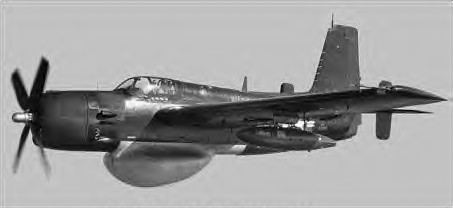In 1942, the US Naval Bureau of Aeronautics asked the Grumman company about a possible successor to the company's highly successful Avenger torpedo bomber. Further discussions led Grumman to initiate development of such a replacement in 1944, to be designated "XTB2F-1". The XTB2F-1 would eventually lead to the Guardian, but through a convoluted path.
The initial concept for the XTB2F-1 was for a multi-seat, carrier-based torpedo bomber with twin Pratt & Whitney (P&W) R-2800-22 Double Wasp radial engines. The XTB2F-1 would be able to carry up to 3,600 kilograms (8,000 pounds) of bombs or torpedoes, and would have an extremely long range of up to 5,950 kilometers (3,700 miles).
Unfortunately, the XTB2F-1 proved far too ambitious, as the design was simply too big and heavy to be flown off most of the US Navy's aircraft carriers. The XTB2F-1 was cancelled in January 1945, in favor of a more conservation option, a derivative of the Grumman F7F Tigercat twin-engine fighter designated the "XTSF-1".
However, Grumman had been working on a third design, with the company designation "G-70", for several months, and the Navy found the G-70 attractive. In February 1945 the service decided to abandon the XTSF-1, awarding a contract to Grumman for three G-70 prototypes, with the Navy designation "XTB3F".
 Two of the prototypes would be "XTB3F-1s" and the third would be an "XTB3F-2". They were to be "mixed-power" aircraft, with a P&W R-2800-6 Double Wasp, providing 2,300 horsepower and fitted in the nose, and a turbojet fitted in the tail and fed by oval intakes in the leading edges of the wings. The turbojet was to be used to provide additional power for takeoffs and combat emergencies.
Two of the prototypes would be "XTB3F-1s" and the third would be an "XTB3F-2". They were to be "mixed-power" aircraft, with a P&W R-2800-6 Double Wasp, providing 2,300 horsepower and fitted in the nose, and a turbojet fitted in the tail and fed by oval intakes in the leading edges of the wings. The turbojet was to be used to provide additional power for takeoffs and combat emergencies.
The XTB3F-1 would be fitted with a Westinghouse 19XB-2B turbojet, while the XTB3F-2 was to be fitted with a with a Westinghouse 24C-4B turbojet. They were otherwise similar, featuring a crew of two, sitting side-by-side; a warload of up to 1,800 kilograms (4,000 pounds) of bombs, torpedoes, or rockets; and twin fixed forward-firing 20-millimeter cannon.
The initial XTB3F-1 prototype flew on 19 December 1945, with Grumman test pilot Pat Gallo at the controls. The turbojet intakes were masked off because of problems encountered in ground tests, and in fact the jet engine proved to be a bad idea and was quickly removed without ever being used in flight.
On 24 December, the Navy decided that they no longer needed a new torpedo bomber, and told Grumman that they wanted an ASW aircraft instead. There was no way at the time to cram all the necessary ASW gear into a single aircraft, and so two variants of the "Guardian", as it was named, were planned, with the pair to act as a "hunter-killer" team.
The two unbuilt prototypes were modified towards this end. The single XTB3F-2 prototype was built as the "hunter" member of the team, without the Westinghouse turbojet engine, but with two more seats for radar operators and a large ventral radome fitted where the bombbay had been, accommodating APS-20 ocean search radar. This aircraft became the "XTB3F-1S" and first flew in November 1948.
The second XTB3F-1 prototype was built as the "killer" member of the team, retaining the bombbay but deleting the cannon, adding a third seat, and providing a searchlight and short-range radar. This aircraft became the "XTB3F-2S" and first flew in January 1949, with both aircraft performing naval flight tests in February.
By this time, the Guardian had already been ordered into production. The XTB3F-1S "hunter" was built as "AF-2W" (originally "AF-1S") Guardian, and the XTB3F-2S "killer" was built as the "AF-2S". The first production AF-2S Guardian flew on 17 November 1949. Qualification trials were conducted from May 1950 through November 1951, with the first operational aircraft going into service in October 1950.
 Manufacturer: Grumman
Manufacturer: Grumman
Role: Anti-Submarine aircraft
Powerplant: One 2,400 hp Pratt & Whittney R-2800-48W
Length: 43 ft 4 in
Wingspan: 60 ft 8 in
Height: 16 ft 2 in
Empty Weight: 14,580 lbs
Max. Weight: 25,500 lbs
Max. Speed: 317 mph
Ceiling: 32,500 ft
Range: 1,500 miles
Armament: One 2,000 lb torpedo or two 2,000 lb bombs or two 1,600 lb depth-charges in weapons-bay
